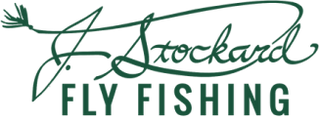by Nathan Wight, Durham ME, J. Stockard Pro Tyer
Again this year we called on the talents of the J. Stockard Pro Tyer Team to create an eye-catching image for our catalog cover. Check out Nate Wight’s turn on the traditional Copper John. Nate, who owns North Woods Fly Co., is a 4th generation Maine guide and a tyer with 30+ years’ experience.
History of the Copper John
In 1993 John Barr began to develop a nymph that we know today as the Copper John. Although the Copper John does not imitate any given species of insect, it has proven itself to be a fish catching fly here in the United States and around the world. There have been many variations of the fly over time, but all are based on the same copper wire body.
A couple of years ago I started tying this double wire jig hook variation. One of the many advantages to this style is that you can change up wire colors. For example, use small black wire with brassy copper wire to achieve a slightly darker fly without losing all the original copper flair.
Copper John Recipe / Materials List
Hook: Wide Gap hook in Size 14. You can adjust the size of the hook and bead to suit your own preferences
Bead: 2.8 Slotted tungsten in Gold.
Thread: 30D black Gel Spun.
Tail: Brown dyed Duck wing Biots.
Body: Small and Brassie sized copper wire.
Abdomen: Peacock Black Ice Dub.
Collar: Dun colored Hare’s Mask
Copper John Tying Instructions
Start by placing a tungsten bead on your favorite wide gap jig hook then secure it firmly in your vise.

Lay down a base of thread starting behind the bead and working it back to the beginning of the bend of the hook. I prefer using 30D gel spun because of its strength and its ability to lay flat on the hook shank.

Select two Biots from a brown dyed Duck Quill. Bind them onto the hook making their length about the same as the shank of the hook. Be sure the natural curve of the Biot turns the tips outward. Return your thread to behind the bead.

For this fly I used small and brassie sized wire. Bind the wire down on the opposite side of the hook to where you tied the tails and return your thread to behind the bead. Be sure to use good touching wraps of thread; this will help with tighter wire wraps.

Next, wind both wires simultaneously towards the bead. Another little trick for nice tight wraps is to use your thumbnail to push the wires back against your previous wraps. When you get behind the bead, tie off both wires and either clip or twist the remaining off.



To create the thorax, apply a small dubbing noodle of peacock black ice dub and wrap it tight to the back of the bead. You only need two to three turns of dubbing.

For the collar of this fly I used Dun colored Hares mask. It doesn’t take much to make a buggy collar; a small pinch is all that’s needed. I apply the Hares mask to the fly by utilizing the split thread method. The benefits of using gel spun is that you can easily split your thread with either a bodkin or thread splitting tool by simple spinning your bobbin counterclockwise until it flattens out. By doing this method you save space over using a traditional dubbing loop. Once you’ve applied your hares mask collar, apply glue and whip finish.
More About Nate Wight
Nathan's favorite flies: Although he ties a lot of Euro nymph flies, Nathan’s real passion is for large predator streamers and top water flies.
Find Nathan @: www.instagram.com/n.w.flyco/, www.facebook.com/n.w.flyco, www.northwoodsfly.com
About Nathan: Growing up in the western mountains of Maine, Nathan was surrounded by some of the best native brook trout and landlocked salmon in New England. Taught by his father, he quickly developed a passion for fly fishing and is 4th generation ME guide. With 30+ years of tying experience, he opened North Woods Fly Co. in 2015. Although he loves to tie classic Maine streamer flies, there is no pattern that he won’t tie or replicate for his clients. Nathan has fished throughout New England, parts of the US west, northern Canada and the Canadian Maritime’s. He is part of a program that brings casting, fishing and fly tying to Veterans in Maine and also teaches group and one-on-one tying lessons. He regularly ties at the Fly Fishing Shows in Marlboro MA and Edison NJ, most often in the HMH booth.
How to Fish the Copper John
A Copper John is a versatile fly pattern that can be used in a variety of fishing situations. When fishing with a Copper John fly, it's important to consider the water conditions and the type of fish you're targeting. Here are some tips on how to fly fish effectively with a Copper John:
Cast the Fly in the Right Location: To increase your chances of success, it's important to cast the Copper John fly in the right location. This may involve casting the fly upstream or downstream, depending on the water flow. You may also want to cast the fly near structure, such as rocks or logs, where fish are likely to be hiding.
Vary the Depth of the Fly: Fish often feed at different depths depending on the time of day and the water temperature. To increase your chances of catching fish, it's a good idea to vary the depth of your Copper John fly. You can do this by adjusting the weight of the fly, using a sink tip or intermediate line, or using a strike indicator to help adjust the level of the fly under the water’s surface.
Try Different Colors and Sizes: Copper John flies come in a variety of colors and sizes, so don't be afraid to experiment to see what works best for the fish you're targeting.

